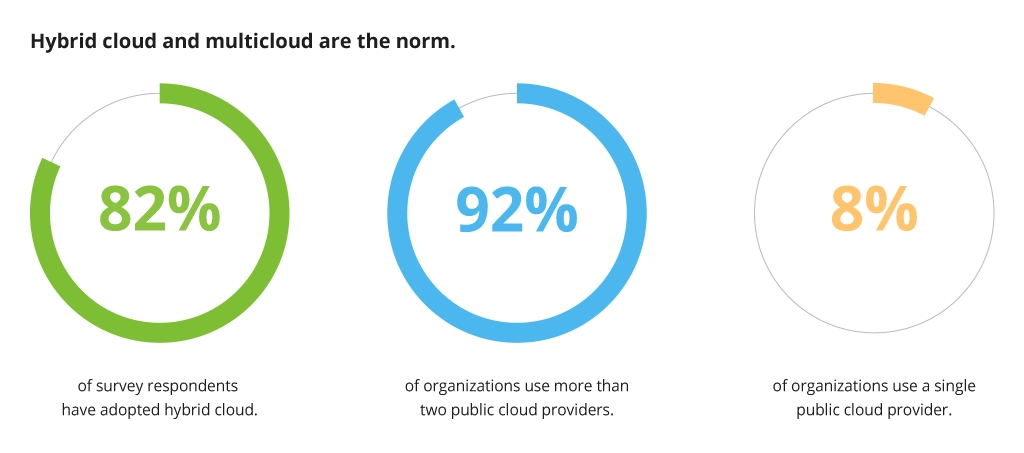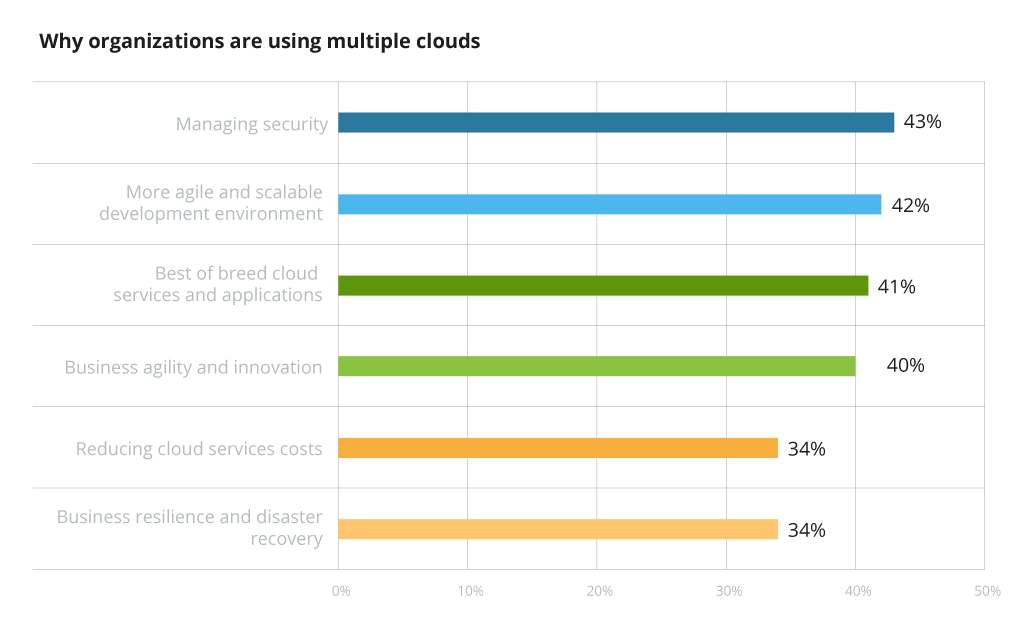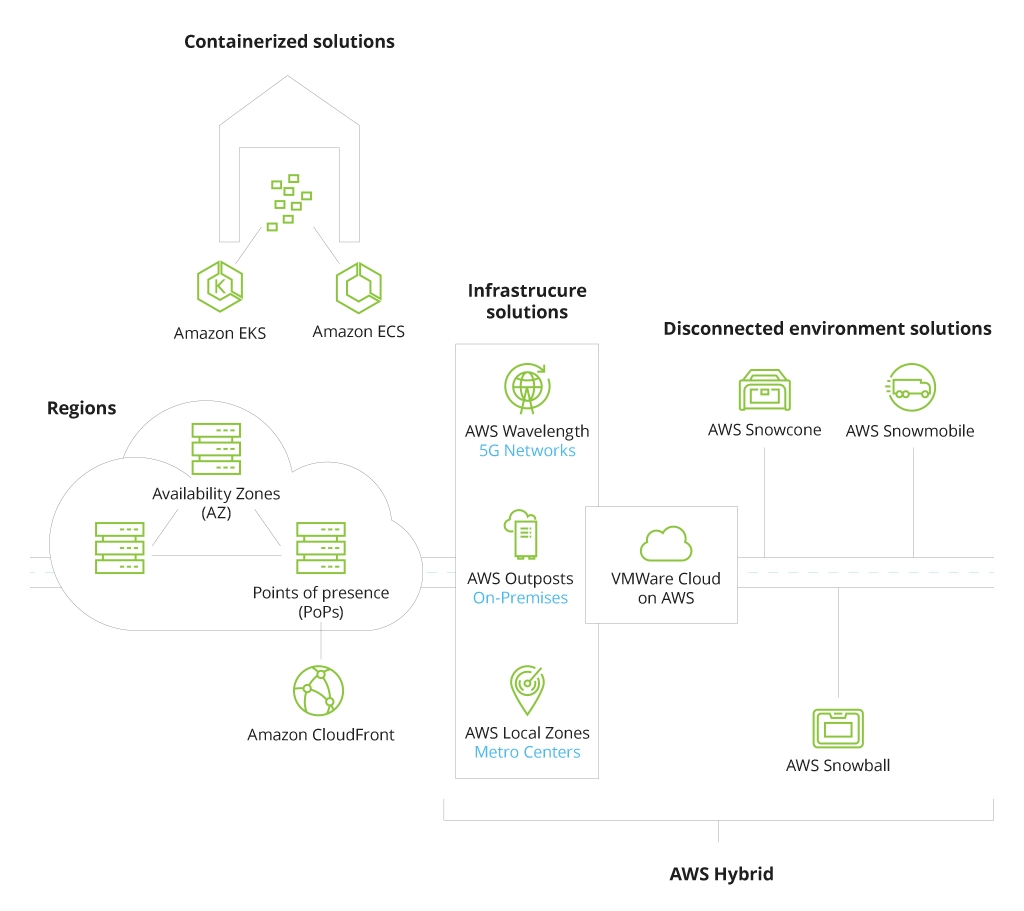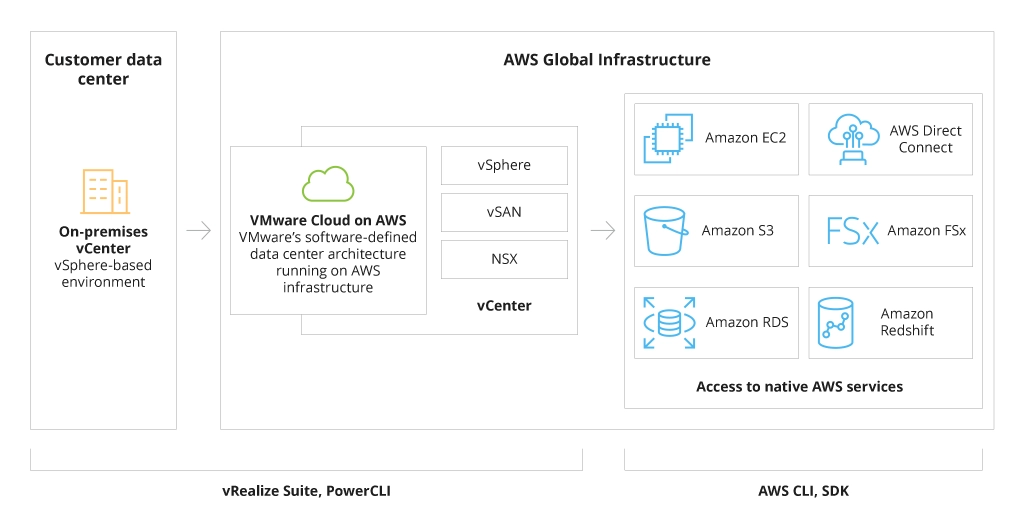AWS Hybrid Cloud Solutions: Overview of the Key AWS Stack Capabilities
Previously, we covered the benefits and use cases of building a hybrid cloud on Microsoft Azure. In this blog post, we will focus on another market-leading cloud platform – AWS. We will start with a quick recap of what is the hybrid cloud and explore why its adoption is on the rise across many industries. The second part of this blog post is your definitive guide to the AWS stack, which includes an in-depth overview of the key AWS hybrid cloud solutions, their capabilities, benefits, and use cases.
What is a Hybrid Cloud and Why Businesses Rush to Adopt It?
A hybrid cloud integrates private, public, or edge cloud services with on-premises infrastructure, enabling centralized management and orchestration of computing resources. In essence, a hybrid cloud blurs the boundaries between different environments and forms a unified cloud estate that brings in the best of both worlds. By building a hybrid cloud architecture, organizations can maintain sensitive data or business-critical applications in a private cloud or on-premises while accessing the benefits offered by hyper-scalers, such as AWS, Microsoft Azure, or Google Cloud.
Hybrid cloud adoption is steadily becoming the new normal among business leaders. Recent research by Cisco states that the overwhelming majority of the surveyed 2,500 organizations in 13 countries have already adopted the hybrid cloud.
Hybrid Cloud Adoption Rates in 2022
Moreover, the use of a multi-cloud approach (mesh of two or more clouds) rapidly gains traction as enterprises aim to build a futureproof and scalable infrastructure with best-of-breed public cloud services.
Global Hybrid Cloud Market Size & Drivers of Adoption
The global hybrid cloud market was valued at $85 billion in 2021 and is anticipated to reach $262 billion by 2027 at a 20.6% CAGR, according to this research. The exponential growth of the global cloud market (which may exceed $1 trillion by 2030), combined with the increasing adoption of AI, IoT, big data, and edge computing that require powerful computing capacities, are driving the surge of the hybrid cloud. Most importantly, a hybrid cloud offers the opportunity to establish a robust security posture, enable unmatched scalability, accommodate multiple cloud interoperability, and drive innovation, all while optimizing costs. Due to such valuable benefits and extensive use cases, hybrid cloud adoption is on the rise across BFSI, IT, retail, manufacturing, telecom, and the public sector.
Primary Drivers of Hybrid Cloud Adoption
Key Benefits of Building a Hybrid Cloud with AWS
The triarchy of hyper-scalers accounts for 65% of the global cloud market with AWS as the sole leader. According to Synergy Research Group, AWS owns 34% of the cloud market share in 2022, which exceeds the joint share of its two principal competitors – Microsoft Azure (21%) and Google Cloud (10%).
As a global front-runner, AWS offers a myriad of services to help businesses build versatile hybrid cloud architectures, including computing, storage, operations, security, data management, content delivery, and more. AWS hybrid cloud solutions can be tailored to suit even the most demanding requirements, and operate across any environment, be it a local data center, a retail site, or an edge of a 5G network. By leveraging the capabilities of AWS hybrid cloud, organizations can:
- Drive innovation by modernizing applications and services that require on-premises residence
- Access consolidated management tools, services, and APIs to improve IT productivity and save costs
- Improve the performance and end-user experience of latency-dependent applications or systems by deploying them in close proximity
- Optimize time, resources, and reduce operational risks with a fully managed infrastructure
- Utilize the public cloud to store sensitive data in specific locations and meet the required security/compliance terms
- Seamlessly migrate and run VMware workloads in a hybrid AWS environment
- Maintain business continuity and operational resilience with a robust AWS backup, disaster recovery, and IAM.
Overview of AWS Hybrid Cloud Solutions
The core AWS hybrid cloud services are subdivided into four groups – Regions, Containerized Solutions, Infrastructure, and Disconnected Environment Solutions. These services cover a broad spectrum of business needs and use cases – from strengthening the resilience of apps and databases to ensuring ultra-low latency via 5G network or performing exabyte-scale migrations to AWS.
AWS Regions & Availability Zones
The AWS Global Infrastructure spans 87 Availability Zones (AZs) in 27 Regions across the Americas, EU, APAC, South Africa, and the Middle East. Each AWS Region is a separate geographical location that houses a cluster of three or more discrete data centers that form an Availability Zone. All AZs are connected with powerful, ultra-low latency networks that enable synchronous data replication.
The entire AWS infrastructure is inherently designed to maximize the availability, scalability, and fault tolerance of the client’s databases and applications. The data center clusters within an AZ are physically separated to avoid the impact of potential natural disasters. Moreover, even during a hardly imaginable internal AWS failure or outage, the data can be routed rapidly to an adjacent AZ. As a result, by distributing and running apps or services on nearby AWS AZs your organization can ensure ultimate resilience while meeting the legal and security requirements.
If AWS AZs are unavailable in your region, you can use one of 410+ globally dispersed edge locations known as Points of Presence (PoPs) combined with Amazon CloudFront – a content delivery network service. Together, these tools enable rapid distribution of static and dynamic content to the nearest AWS data center. Due to low latency and enhanced delivery performance, PoPs and CloudFront is a perfect use case for streaming, on-demand videos, social media, and other apps.
Division of Core AWS Hybrid Cloud Solutions
AWS Hybrid Containers Services
AWS offers two dedicated services to help businesses run and manage containers at scale, both in the cloud and on-premises.
Amazon ECS Anywhere (Elastic Container Service) is a fully managed service that provides consolidated and convenient cluster management, scheduling, and monitoring for containerized applications across any environment. By implementing this service, you can easily run and orchestrate container workloads without moving away from your on-premises data center or purchasing costly third-party management software.
Amazon EKS Anywhere (Elastic Kubernetes Service) is a similar service that simplifies the creation and running of on-premises Kubernetes clusters. In addition to a unified toolset for handling Kubernetes operations, this service enables automated cluster management and lifecycle support.
By implementing Amazon ECS and EKS Anywhere you can effectively control your resources and traffic while enhancing the performance, governance, and security of your applications.
AWS Infrastructure Solutions
AWS Wavelength embeds computing and storage services at the edge of 5G networks of world-class CSPs, including Verizon, Vodafone, KDDI, Bell, and others. The service is dispersed across Wavelength Zones – locations of CSPs that are linked to a specific AWS Region. You can extend a virtual private cloud, containers, or other workloads to one or more Wavelength Zone to access the benefits of 5G networks. Consequently, with the help of AWS Wavelength, your IT teams can engineer cutting-edge, ultra-low latency applications by implementing the familiar AWS tools and APIs. The most popular use cases for this service are:
- High-resolution live video streaming, gaming, and AR/VR solutions
- AI/ML or Computer Vision software for telemedicine, retail, and smart manufacturing
- Autonomous vehicles and modern in-vehicle infotainment systems
AWS Local Zones is a connectivity service tailored for large metropolitan areas or industrial sites. Similarly to AWS Regions and Points of Presence, it allows accessing and deploying AWS computing, storage, content delivery, or other services in on-premises locations to meet extremely low latency and local data residency demands. In addition to serving latency-sensitive use cases that require close proximity to end-users, such as AR/VR apps or live streaming, AWS Local Zones perfectly suits governmental organizations, healthcare facilities, banks, and other heavily regulated industries.
The name AWS Outposts is completely justified, as this service fortifies your on-premises data center or any other local facility with native AWS services delivered from dedicated hardware. AWS Outposts provides full-size racks, 1U or 2U servers, and switches tailored for the networking and power requirements of your facility. The service is fully managed and supported by AWS, which reduces operational risks and eliminates extra expenses for software updates and patches, hardware maintenance, or support of multiple vendors.
Just like the majority of AWS hybrid cloud services, AWS Outposts is designed to extend the AWS capabilities into on-premises infrastructure to support workloads that require low latency, local data processing, and specific data residence. Moreover, by building an AWS Outposts you can facilitate the migration of legacy on-premises applications to the cloud by segmenting the process into smaller parts while maintaining the required latency-sensitive connectivity between components.
VMware Cloud on AWS is a joint managed service offering from the two companies that allows migrating or extending on-premises VMware environments to the cloud. This service significantly facilitates the shift to the hybrid cloud, as there is no need to purchase any additional custom hardware or re-engineer the existing IT ecosystem. You can simply use the same VMware provisioning, storage, and management tools and Cloud Foundation technologies (vSphere, vSAN, vCenter, and NSX) across your on-premises and AWS cloud environments. Most importantly, you can receive access to 200+ AWS services, including computing, data analytics, security, AI/ML, IoT, and much more. As a result, VMware Cloud on AWS enables a seamless and cost-efficient cloud transformation and provides an opportunity to modernize or build new next-gen applications with a holistic portfolio of cloud-native services.
VMware Cloud on AWS Infrastructure
AWS Snow Family
AWS Snow Family comprises three services that are designed to deliver storage and computing capabilities to remote locations with unstable network connectivity, facilities that cannot be reached by AWS Availability Zones, or on-premises data centers that require optimization due to limited capacity.
AWS Snowcone service provides compact portable edge devices that are used to ingest, process, store, and transfer data from distant on-premises locations to AWS. Up to 8 TB of data (per one device) can either be transferred online via AWS DataSync or physically transported to an AWS data center.
Snowcone devices are perfect for harsh environments with limited space, such as manufacturing plants or offshore oil rigs, which operate IoT solutions. Due to their small size, Snowcone devices can be placed near remote machinery, process the data from IoT sensors, and deliver near real-time insights. Additionally, this service can be applied across other use cases, including fleet data analysis, content distribution, or a minor data migration project.
AWS Snowball is an identical service that offers portable edge computing devices of a larger scale to securely migrate dozens of terabytes or even petabytes of data to the cloud. Each AWS Snowball device is available in two versions:
- Storage optimized – 80 TB of HDD storage, 40 vCPUs, and 40 GB network connectivity, which suits high-volume data aggregation and migration scenarios.
- Compute optimized – 28 TB storage, 104 vCPUs, and 100 GB network connectivity that are best fit for complex data processing, IoT analytics, AI/ML solutions, etc.
The pinnacle of the Snow Family is the AWS Snowmobile service that enables exabyte-scale data migrations from on-premises to AWS. Snowmobiles are portable data centers, each having up to 100 PB of storage capacity. These data centers are deployed in tamper/water-resistant and GPS-tracked shipping containers that are pulled by semi-trucks. After arriving at your site, a Snowmobile connects directly to your network to perform rapid data migration, and then transfers it to one of the Regions where the data is uploaded to AWS. This service is a good choice if you want to run Big Data analytics on AWS or migrate enormous volumes of data from your on-premises data center to the cloud in a matter of weeks.
How AWS Snow Family Services Work
Conclusion
As a next-gen platform that leads the entire cloud market, AWS can become a powerhouse for ultimately efficient and resilient hybrid cloud estates that meet the most demanding requirements. You can extend a myriad of native AWS cloud services to anywhere you need them and obtain the best of both worlds – enhanced agility, limitless scalability, and optimized costs combined with ensured security and compliance.
![AWS Hybrid Cloud Solutions [banner]](https://www.infopulse.com/uploads/media/banner-1920x528-hybrid-cloud-on-aws-benefits-and-use-cases.webp)







![Cloud-Native for Banking [thumbnail]](/uploads/media/cloud-native-solutions-for-banking_280x222.webp)
![Generative AI and Power BI [thumbnail]](/uploads/media/thumbnail-280x222-generative-AI-and-Power-BI-a-powerful.webp)
![Cloud Native vs. Cloud Agnostic [thumbnail]](/uploads/media/thumbnail-280x222-cloud-agnostic-vs-cloud-native-architecture-which-approach-to-choose.webp)
![DevOps Adoption Challenges [thumbnail]](/uploads/media/thumbnail-280x222-7-devops-challenges-for-efficient-adoption.webp)
![Azure Monitor for SAP [thumbnail]](/uploads/media/thumbnail-280x222-azure-monitor-for-sap-solutions-an-overview.webp)

![Mortgages Module Flexcube [Thumbnail]](/uploads/media/thumbnail-280x222-Secrets-of-setting-up-a-mortgage-module-in-Oracle-FlexCube.webp)
![Digital Alignment Drivers [thumbnail]](/uploads/media/thumbnail-280x222-the-top-forces-driving-digital-alignment.webp)
![AWS vs. Azure Cloud Platform [Thumbnail]](/uploads/media/thumbnail-280x222-comparison-of-aws-vs-azure-when-each-cloud-platform-works-best.webp)
![Cloud-Native Maturity Model Assessment [thumbnail]](/uploads/media/thumbnail-280x222-what-Is-the-cloud-native-maturity-model-definition-and-assessment-criteria.webp)